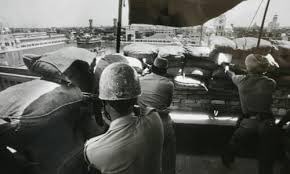On 4 June 1984, while most of Punjab was still asleep, Amritsar residents woke to the sounds of a war zone. At 4.40am, an Army rocket fired from a shoulder-held launcher, slammed into Sri Akal Takht Sahib; the very heart of Sikhi and our highest temporal throne and authority.
Two more rocket blasts shortly followed, shattering the serenity of the Sikh holy city. Witnesses described the impact of the blasts as being so strong that they thought the whole complex had collapsed. After this the ferocity of the firing escalated throughout the day, unabated. 



There was no public announcement from the Army prior to the shelling. No opportunity for safe exit from the Darbar Sahib complex was provided to over 10k innocent and unarmed Sikh men, women and children who had been deliberately trapped in the complex by the Army the day before.
This was proven unequivocally in 2017 by Amritsar District and Sessions Judge Gurbir Singh who gave a ruling stating there was absolutely no evidence that the Indian Army provided warnings for pilgrims to leave the Darbar Sahib complex before commencing their assault.
Judge Gurbir Singh wrote in his ruling, "There is no evidence that the Army made any announcements asking ordinary civilians to leave Golden Temple complex before launching the operation in 1984...There is no written record of any public announcement by the civil authorities
requesting the people to come out of the complex. No log of vehicles used for making such announcements is there…”
Judge Gurbir Singh’s judgement highlights the intentional and horrific human rights violations, committed against Sikh civilians, by the Indian Army.
Judge Gurbir Singh’s judgement highlights the intentional and horrific human rights violations, committed against Sikh civilians, by the Indian Army.
The ruling also gives further weighting to the findings of the “Oppression in Punjab” report filed by human rights group Citizens for Democracy. A day after the report was released, it was banned and confiscated, the authors were arrested and charged with sedition.
https://twitter.com/A__Kaur_/status/1665058245462081536
Heavy artillery and mortar were fired at Darbar Sahib with a vengeance by the Indian Army, as though they were attacking an alien and enemy country. In fact, General Kuldip Brar had referred to the Sikhs inside the complex as the ‘enemy’ when addressing troops before the attack.
In addition to heavy firing from high calibre guns, Army soldiers also threw mortar shells and poisonous gas canisters inside Sri Akal Takht Sahib and other buildings in the complex. At the same time, helicopters hovered and fired from above.
Some of those helicopters guided the firing squads by providing a circle of light around targets. Witnesses reported seeing Sikh civilians being blown to pieces. Hundreds of dead bodies, including men, women and children covered the Parikarma of Darbar Sahib.
In complete violation of the Geneva Convention and the @UN Charter, Red Cross volunteers were not only prevented from providing medical aid to the injured civilians, they were detained at Jallianwala Bagh, over a kilometre away from the Darbar Sahib complex.
The brutal scenes of destruction, chaos, and devastation inside the Darbar Sahib complex were so horrific that the Indian Army deliberately violated international laws in order to avoid any public scrutiny or external witnesses to the carnage they had committed against the Sikhs.
Over the course of 4 June 1984, the Indian Army killed hundreds of innocent Sikh civilians, and destroyed the historic 18th century Ramgharia Bungas, the water tank located behind the Guru Nanak Niwas and multiple buildings around the complex, reducing them to rubble.
Against all odds, between 80 to 150 valiant Sikh warriors led by Sant Jarnail Singh Ji Khalsa Bhindranwale and Major General Shabeg Singh, one of the greatest military strategists and war heroes of modern India, continued to defend Darbar Sahib, protecting it from invasion.
These brave warriors, armed at best with ordinary weapons like guns, rifles and carbines, remained in Chardi Kala (high spirits) and prevented the Indian Army with its tanks, heavy field artillery, Armed Personnel Carriers and helicopters, from entering Sikhs’ holiest of shrines.
• • •
Missing some Tweet in this thread? You can try to
force a refresh

 Read on Twitter
Read on Twitter













